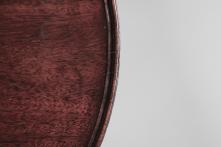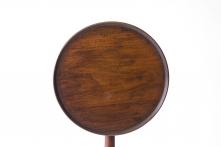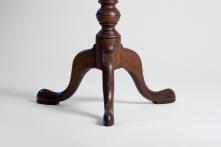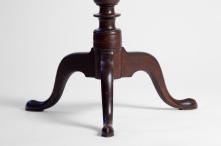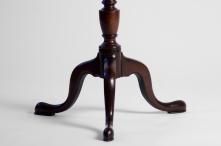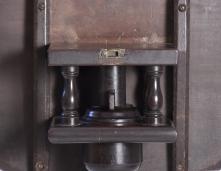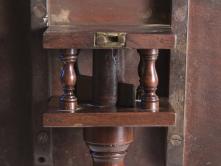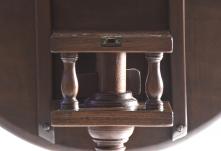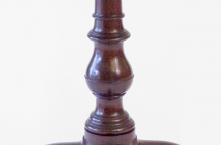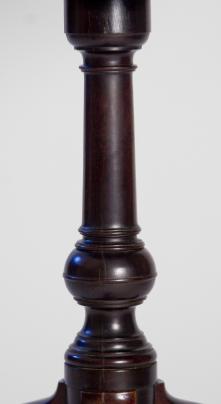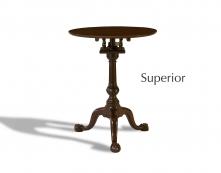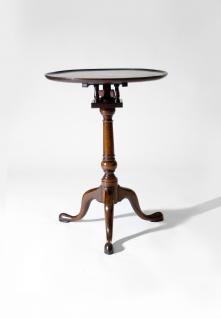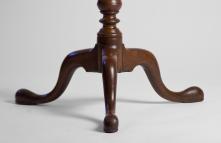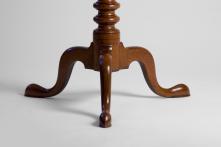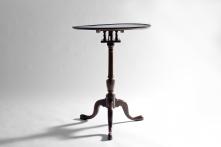Article
The Connoisseur’s Eye On Philadelphia Candlestands
- Date:
- April, 2009
- Author:
The opportunity to pursue fine examples of early American furniture has never been better than it is now. With so many options in the market, enthusiasts should be patient and dogged in their evaluation of any object they hope to obtain.
In April 2008, I wrote an article outlining the criteria for evaluation of any American period piece of furniture. In the spirit of Albert Sachs “The Fine Points of Furniture: Early American: Good, Better, Best, Superior, Masterpiece”, this article was intended as a reference guide for new collectors. In the article I introduced 7 points for the evaluation of a period piece of furniture: origin, condition, form, provenance, rarity, finish and paint and attribution or known maker.
Using the 7 points of criteria, I evaluated the Philadelphia Chippendale side chair. This year we will look at using those points to evaluate the Philadelphia Queen Anne and Chippendale candlestand.
The Evolution of the Candlestand in Colonial America
Candlestands were first introduced in the William and Mary period [England 1680-1710, America 1690-1730]. While they served an obvious purpose, they quickly become an elegant expression of design. Unlike other types of furniture that made their presence known through shear height and space, the candlestand offered a quiet presence in the room. For almost all the candlestands produced in the 18th century, the lathe was the tool of choice. William and Mary examples showed ball feet, bold turnings in the legs, drop finials, vase pedestals, and sometimes non-rotating tops which occasionally displayed a dish molding around the circumference.
In Philadelphia, the Queen Anne period [England 1700-25, America 1720-60] became the high-point in candlestand production. Although there are examples of William and Mary candlestands with birdcages, their use became almost ubiquitous in fine cabinetmakers shops during this period. Not only did the birdcage make the candlestand more functional, it also served to provide a more consistent definition and sculptural importance from the top to the feet. As the top of the candlestand became more pronounced, so did the pedestal. Elaborate turnings flanking the suppressed ball were added to the shaft elevating the candlestands functional purpose to an even greater art form. Lastly, the turned legs of the William and Mary period gave way to the more refined cabriole legs of the Queen Anne period. While candlestands were primarily made with walnut, maple and cherry, it was in this timeframe that mahogany became the choice de rigueur for fine Philadelphia candlestands.
Interestingly, little changes were made to the American candlestand during the Chippendale period [England 1740-70, American 1755-85] with two exceptions: the top and the feet. More commonly seen in tea tables, the piecrust top was introduced during this period. More difficult to execute, this feature was rarely applied to Philadelphia pieces. There are a handful of known Philadelphia candlestands with this elaborate feature. Very few of them are in private collections. Almost as rare is the adoption of the claw-and ball foot. Although widely seen in tea tables in this period, Philadelphia candlestands rarely have them. The rarity of both features makes them highly desirable in a candlestand from anywhere in the Americas, let alone Philadelphia. It should be noted that these features were more widely adopted in English and Irish furniture of the same period.
Although there are examples of candlestands being made all the way into the late neoclassical period, it can be argued that the Hepplewhite period [England 1770-95, America 1780-1800] was the candlestands last hurrah. Popular techniques of the Hepplewhite period include spider legs, urn or vase pedestals and oval or square tops with shaped corners. Adding inlay to the top was also not uncommon during this period.
The Anatomy of the Philadelphia Candlestand
The whole is greater than or equal to the sum of its parts. Like many things in life, the gestalt of a candlestand ultimately defines its importance. We all know an orchestra with some parts played to perfection means little if even one member manages to play out of tune or beat. Like an orchestra, one part or component of furniture executed well, does not mean that the entire finished product will work. Successful cabinetmakers wrote down or saw the finished product in their head long before they began making the components of a candlestand. Below we will go over the most common elements of a candlestand and how to evaluate them.
Top

It is most common and desired to have a dish-top on a Philadelphia candlestand. The images below show an overall of a top and a close-up of the dish molding.
The examples above illustrate the subtle molding that surrounds the circumference of the top. Most dish moldings from the Philadelphia area are similar to the ones below. As you get further away from Philadelphia in Pennsylvania, you can find primitive examples of dish top moldings that are either more dramatic or missing altogether.
Birdcage
A candlestand can be evaluated on whether it has a birdcage and whether it complements the overall aesthetic presentation of the piece. In other words, the omission of a birdcage can impact the value and aesthetic quality of a candlestand, but does not necessarily improve it.
Shaft / Pedestal
Usually, the most dramatic aspect of a candlestand is in the shaft. Starting with subtle ring(s) below the birdcage the shaft typically expands to a wider turned pedestal base that bands three legs with large sliding dovetails and reinforced with a three-lobed iron plate or spider. Emphasis is largely centered on the turned base of the shaft often called the pedestal.
Examples of the Queen Anne / Chippendale shaft and pedestal:
Because the pedestal is such a significant part of the aesthetic value, you can characterize the difference between them. Like any other aspect, their presentation is often relative to the overall appearance of a candlestand, but they are an excellent measure of origin, period and craftsmanship.
Examples of period pedestals:



Pennsylvania William & Mary
Philadelphia Queen Anne /Chippendale
Philadelphia Hepplewhite
The most desirable form for a Philadelphia candlestand is the Queen Anne / Chippendale suppressed ball pedestal.
Below are three strong examples of Philadelphia Queen Anne pedestals:



Better
Best
Superior
The first image labeled “Better” demonstrates a good execution of the suppressed ball form. There is no question it was made in Philadelphia. The “Best” suppressed ball shown in the middle is a rare tear-drop shape with an elegant elongation. This form is desirable, rare and a fine example of Philadelphia craftsmanship. Finally the “Superior” ball shows bold execution and perfect proportions. The subtle scoop below the ball is an illustration of elegant restraint. Both design and skill are matched in this example.
Legs
Posture is critical to the successful presentation of a candlestand. The rise and slope of the cabriole leg in particular can make the difference between modesty and excellence. Being the preferred form for Philadelphia candlestands, we’ll examine what makes a great cabriole leg.



Good
Better
Superior
Like a high-heeled shoe, the greater the lift, the better the presentation. The “good” legs have modest rise. The “Better” legs have a more dramatic slope, but their negative space is less defined. The “Superior” legs successfully rise quickly from the heel to provide more drama, while providing a more pleasing angle towards the base of the pedestal.
Feet
Perhaps the final note in the composition of a candlestand is the feet. Most Queen Anne through Hepplewhite candlestands are on snake feet.
Below are Philadelphia Queen Anne and Chippendale examples:



Good
Better
Superior
The “Good” image of a Queen Anne candlestand foot is appropriate, but a tad bulbous. The beveled foot in the “Better” example shows a more desirable and attractive form. To rise to superior for the Philadelphia candlestand, a foot should be truly exceptional. Adding a finely carved claw-and-ball foot to the candlestand is just the trick. Very common in tea tables during the Chippendale period, the claw-and-ball foot became one of its signatures. Whether it was a matter of preference, cost or survival, very few existing candlestands include this feature.
Execution
Execution takes us back to the whole being greater than the sum of the parts. Each of the elements listed above contribute towards the production of a candlestand. In a Philadelphia candlestand, each element should not overshadow the other. Below is an example of a Chester County candlestand. Desirable to those who collect more eccentric pieces (note the round birdcage unique to the area), this candlestand reflects a design that disproportionately splays the legs beyond the diameter of the top.

Walnut Queen Anne Candlestand, Chester County, PA
While this is charming as a Chester County piece, it would be considered primitive in comparison to a fine Philadelphia candlestand. Proportion and execution is really a reflection of consistency. Each architectural element should be balanced in harmony with the other to create that piece that rises to excellence. We will now use all the tools of evaluation we just discussed to categorize three Philadelphia Queen Anne and Chippendale candlestands into “Good, Better, Best, Superior.”
GOOD. BETTER, BEST, SUPERIOR
It should be noted from the onset that the candlestands reviewed in this article are all in the “pros”. There are plenty examples of lesser forms of candlestands out there. This evaluation is drawing upon variations of Philadelphia Queen Anne and Chippendale forms. Those forms are still considered among the most desirable of the 18th century. Once you get in the top 10 percent, the differences are subtle. Those delineations are examined below.
Good

Walnut Queen Anne Candlestand, Philadelphia, PA, c. 1770
Let’s evaluate the candlestand above using the tools we’ve outlined in this article.
Characteristics of Review
Evaluation
Origin
Although many elements of this candlestand contribute towards a Philadelphia attribution, the suppressed ball pedestal is the most telling factor. Compared to other candlestands made outside Philadelphia, this suppressed ball was executed by a Philadelphia trained cabinetmaker.
Condition
The top on this candlestand is slightly warped. Otherwise, the candlestand is in excellent condition.
Finish
This candlestand has a nice finish consistent with most candlestands you’ll find of this period.
Provenance
Like most early American furniture, this candlestand does not have a known provenance.
Rarity
The Philadelphia Queen Anne candlestand is considered desirable, but not rare.
Form
Top
Although it is a dish-top, and warp in the top is not uncommon, it does distract the eye.
Birdcage
Appropriate and well-proportioned for this candlestand. Having the birdcage does make it more desirable.
Shaft/Pedestal
The shaft and pedestal are both well-executed and proportioned. An excellent example of Philadelphia cabinetmaker work.
Legs
The slope and rise on these legs are considered fair for a Philadelphia piece. The lift of the legs from the heel is not quite as dramatic as finer candlestands.
Feet
The feet are appropriate and well-proportioned for the piece. The pad on the snake feet is a nice addition.
Execution
This is a desirable candlestand for most collectors. It has all the characteristics of a fine Philadelphia candlestand. A refined eye would draw attention to the legs and top. For that reason, this candlestand is characterized as GOOD.
BETTER

Walnut Queen Anne Candlestand, Philadelphia, PA, c. 1770
Characteristics of Review
Evaluation
Origin
All the elements are indicative of Philadelphia, especially the finely turned pedestal.
Condition
The top is a nicely proportioned with a dish molding.
Finish
This candlestand has a nice finish consistent with most candlestands you’ll find of this period.
Provenance
Like most early American furniture, this candlestand does not have a known provenance.
Rarity
The Philadelphia Queen Anne candlestand is considered desirable, but not rare.
Form
Top
The top is well proportioned and appropriate for a candlestand of this quality.
Birdcage
Appropriate and well-proportioned for this candlestand. Having the birdcage does make it more desirable.
Shaft/Pedestal
The shaft and pedestal are both well-executed and proportioned. An excellent example of Philadelphia cabinetry.
Legs
The heel on this candlestand immediately rises to a dramatic slope characteristic of the finest candlestands of this period.
Feet
The feet are appropriate and well-proportioned for the piece. The top of the snake foot is beveled to add dimension and the pad on the bottom of the foot adds to the depth.
Execution
This candlestand is an excellent example of a Philadelphia candlestand from the Queen Anne period. Each of its elements complement the other and the condition is excellent. The only way this candlestand could be rated higher is by the addition of something rare or truly exceptional.
BEST

Walnut Queen Anne Candlestand, Philadelphia, PA, c. 1770
Characteristics of Review
Evaluation
Origin
All the elements are indicative of Philadelphia, especially the finely turned pedestal.
Condition
The top is a nicely proportioned with a dish molding.
Finish
This candlestand has a highly desirable old finish seen in only a fraction of candlestands from this period.
Provenance
Like most early American furniture, this candlestand does not have a known provenance.
Rarity
The Philadelphia Queen Anne candlestand is considered desirable, but not rare.
Form
Top
The top is well proportioned and appropriate for a candlestand of this quality.
Birdcage
Appropriate and well-proportioned for this candlestand. Having the birdcage does make it more desirable.
Shaft/Pedestal
The shaft and pedestal are both well-executed and proportioned. The features of this candlestand are slightly bolder than the previously reviewed candlestand. As a result, the suppressed ball on this candlestand is considered particularly strong.
Legs
The heel on this candlestand immediately rises to a dramatic slope characteristic of the finest candlestands of this period. As the pedestal is bolder, so are the legs of this candlestand. The more prominent notch at the base of each leg helps to define a stronger edge on the leg.
Feet
The feet are appropriate and well-proportioned for the piece. Like everything else on this candlestand, the snake feet are bolder than most Philadelphia candlestands. Like the others reviewed, the pad on the foot contributes to improved depth.
Execution
This candlestand is an excellent example of a Philadelphia candlestand from the Queen Anne period. What makes this candlestand BEST is the drama of an old finish coupled with bolder proportions throughout. This piece transcends to sculpture.
SUPERIOR
Walnut Chippendale Candlestand, Philadelphia, PA, c. 1775
Characteristics of Review
Evaluation
Origin
All the elements are indicative of Philadelphia, especially the finely turned pedestal and carved ball-and-claw feet.
Condition
The top is a nicely proportioned with a dish molding.
Finish
This candlestand has a highly desirable old finish seen in only a fraction of candlestands from this period.
Provenance
Like most early American furniture, this candlestand does not have a known provenance.
Rarity
The true Philadelphia Chippendale candlestand is considered very rare. Only a small fraction of candlestands from this period has claw-and-ball feet.
Form
Top
The top is well proportioned and appropriate for a candlestand of this quality.
Birdcage
Appropriate and well-proportioned for this candlestand. Having the birdcage does make it more desirable.
Shaft/Pedestal
The shaft and pedestal are both well-executed and proportioned. The features of this candlestand are even bolder than the previously reviewed candlestand. As a result, the suppressed ball on this candlestand is considered a 10.
Legs
The heel on this candlestand immediately rises to a dramatic slope characteristic of the finest candlestands of this period. As the pedestal is bold, so are the legs of this candlestand. The more prominent notch at the base of each leg helps to define a stronger edge on the leg. What also creates an impression of grace is the immediate rise from the claw-and-ball feet. There is no perceived drag from the foot to the heel. It immediately rises to call your attention to the pedestal of this impressive candlestand.
Feet
The claw-and-ball feet on this candlestand are impressive, bold and exceptionally carved. The feet on this piece send a message of importance to anyone viewing it.
Execution
This candlestand is an exceptional example of a Philadelphia candlestand from the Chippendale period. What makes this candlestand SUPERIOR is the drama of an old finish, bold and well-executed elements and claw-and-ball feet. Only a piecrust top could make this piece any more desirable for a refined Philadelphia collector. In over 30 years, we have never seen one on the market.
MASTERPIECE
Can engage Wendy Cooper if time allows to get an image and details on their piecrust Philadelphia candlestand with ball-and-claw feet.

